|
2007年、英語による神楽坂探訪
英語による神楽坂探訪(2007.10.20)を初めて実施しました。延べ50名の方が参加し、茶道、お座敷遊び、まち歩きをとおして、国際交流を深めました。
私たちは、この経験を踏まえ、もっと多くの外国人が日本文化に親しんでいただく機会を作っていきます。
・神楽坂探訪( かぐらざかたんぼう)
神楽坂は、今なお、料亭の残るまち。歌舞伎役者や芸術家、芸者など、粋人達が愛した着物・小物、茶道具の専門店等、知られざる面白い店を紹介します。遊び心に満ちた「粋」の世界を、プロの通訳案内士と地域のガイドが協力して、外国人にご紹介する初めての試みでした。
・神楽坂まち飛びフェスタ
10月20日~11月4日 伝統的なものからモダンなものまで、90以上のイベントが実施されます。このツァーは、その行事の一つです |
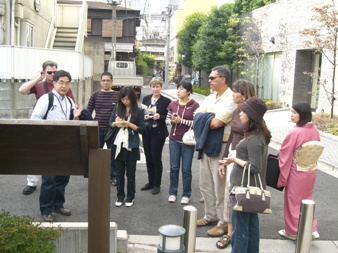 |
Two-hour Walking Tours in English.
October 20,2007;¥3,000 each
9:30-11:30 followed by tea
ceremony and sweets
2:00-4:00 including a fan-throwing game
Explore stone-paved alleys
and unusual shops with us in an area that remains a favorite haunt of kabuki
actors, artists and musicians. See an exclusive ryotei restaurant where geisha
still serve their customers with grace and charm. Learn about “IKI” the Japanese
style or spirit that livens up cultural areas like this. |
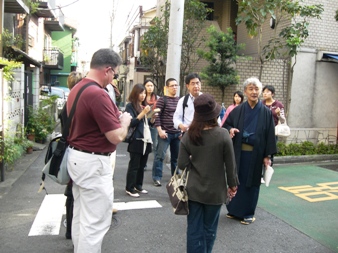 |
Two-hour Walking Tours
in English.
October 20,2007;¥3,000 each
9:30-11:30 followed by tea
ceremony and sweets
2:00-4:00 including a fan-throwing game
Explore stone-paved alleys
and unusual shops with us in an area that remains a favorite haunt of kabuki
actors, artists and musicians. See an exclusive ryotei restaurant where geisha
still serve their customers with grace and charm. Learn about “IKI” the Japanese
style or spirit that livens up cultural areas like this. |
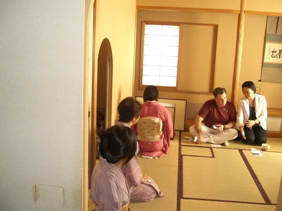 |
>Following the morning tour we provide a tea ceremony and a chance for
you to enjoy traditional Japanese sweets with refreshing tea.
After the afternoon tour you are invited
to watch and participate in a Tosenkyo Fan Throwing Game .
Between October
20th-November 4th,Kagurazaka celebrates its Kagurazaka Machitobi Festival with
over 90 events including an art market and Japanese traditional entertainment
like rakugo,koto music,Noh theater,etc.
|
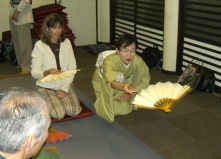 |
◎投扇興は、お座敷遊びの一つです。様々な国の方が楽しみました。遊び方は、 、http://www.tosenkyo.net/をご覧ください。
◎投八拳(とうはちけん)を見学しました。 http://homepage1.nifty.com/tohachi/index.htm
◎に掲載されました。→
◎山内あかりのミュージックカフェで放送されました。 http://ameblo.jp/patio-music-cafe/
◎FEN(ラジオの米軍放送)でも紹介されました。
◎ヘラルド朝日に紹介されています。
|
東京新聞の報道 → http://www.tokyo-np.co.jp/article/tokyo/20071021/CK2007102102058000.html
|
|
街歩きで日本文化を体験してもらうという「外国人のための粋なまち神楽坂探訪」が二十日、新宿区神楽坂であり、米国やフランス、マレーシアなどの延べ約五十人がお茶やお座敷遊びの投扇興(とうせんきょう)に挑戦した。
投扇興は扇を台の上に置かれた蝶(ちょう)といわれるいちょう形の的に投げて当てる遊び。向かい合って座り、五回ずつ投げ、蝶を落とした後の扇の形で点数を競った。台の上に扇が載るなど高得点が出ると拍手が起きた。
米軍基地に勤める福生市のピート・カシアノさん(42)は「優雅なゲームで楽しい。二百年前にこんなゲームがあったとは興味深い」と感想。中国からの留学生崔娉(スイ・ピン)さんは「簡単そうに見えたが、難しかった。体験するといい思い出になった」と話した。
神楽坂などでまちづくり活動をする人たちが日本文化の紹介を通じて外国人観光客の増加を目指す日本文化体験交流会が、神楽坂のイベント「神楽坂まち飛びフェスタ」にあわせ初めて企画した。
|
|
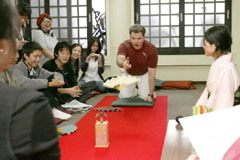 |
|
Asahi.com>ENGLISH>LifeStyle> article Weekend Beat/LIFESTYLE & MORE: Participants
enjoy initial old-Tokyo tours despite a few rough spots 11/03/2007 BY MOMOKO YOSHIDA, STAFF WRITER |
| ヘラルド朝日の記事です |
|
Jiro Sakamoto, a volunteer tour guide in Tokyo's Kagurazaka, led a group
of eight people into a narrow cobblestone alley and gave them a brief history
of the area in his signature husky voice. However, on a clear day on Oct. 20, a few things were new to Sakamoto.
Unlike his usual street clothes, Sakamoto was wearing a dark blue kimono
and zori. Also, after 10 years as a volunteer tour guide for Japanese visitors,
this group was his first to include various nationalities, including an
American and a French woman.Following Sakamoto, Rumi Yamaguchi, a government-licensed
English tour guide, provided simultaneous interpretation. "The black
fences, cobblestones and mikoshi-no-matsu pine trees are the three famous
landmarks of the Kagurazaka alleys," she said in English.The tour
was part of the kick-off events for the Kagurazaka Machitobi Festa 2007,
the area's annual two-week festival held through Nov. 4. It features about
90 events, from modern arts to traditional Japanese performances, such
as rakugo traditional storytelling and Noh performances.The first Machitobi
Festa took place in 1999, organized by local businesses and associations,
including the Kagurazaka Machizukuri-no-kai, a group dedicated to making
the neighborhood more appealing to tourists.
Sakamoto, 62, a member of the group, is the fourth-generation owner of
a local glass store.This year, the Machizukuri-no-kai collaborated with
the Institute for Japanese Culture Experience and Education (IJCEE) to
organize the experimental bilingual tours.
About 50 people participated in the Oct. 20 tours, which visited the neighborhood
in several groups, led by Machizukuri-no-kai volunteer guides and government-licensed
English guides. Tourists included students from China, Korea and MalaysiaKagurazaka
in Shinjuku Ward is an attractive destination for tourists because it retains
the atmosphere of the Edo Period (1603-1867). Kagurazaka is also home to
many France-related institutes including the L'Institut franco-japonais
de Tokyo, French bistros and French expatriates.During the two-hour tour,
Sakamoto pointed out famous ryotei (expensive traditional Japanese restaurants),
an office that dispatches geisha, a long-established ryokan, temples and
shrines.Though the translation was sometimes bumpy and the pace of the
tour less than smooth, Sakamoto was agreeable and Yamaguchi vibrant. Laughter
broke out frequently. Everybody appeared to have a good time, chatting
after spontaneous introductions.The tours' biggest attractions were hands-on activities--the Japanese tea
ceremony and tosenkyo, a traditional fan-tossing game.During the tea ceremony,
participants drank powdered green tea following an age-old ritual and savored
Japanese sweets.In tosenkyo, players toss a fan at a target and score points
depending on the fan's relationship to the target.Chris Wuerthner, a member
of the U.S. Air Force, works for the American Forces Network at Yokota
Air Base in Fussa, Tokyo. He heard about the Kagurazaka tours on one of
AFN's radio programs."It's easy to go to Roppongi, but I thought it
would be nice to see the older part of Tokyo, too," Wuerthner said.
"And I liked it very much."IJCEE was formed in May by graduates
of Tokyo Planner Juku, a project launched in 2004 by the Tokyo metropolitan
government to train people to lead community efforts to attract tourists. |
| Last year, the project developed special tourism courses at the Tokyo Metropolitan
University. The university hopes to offer regular undergraduate and graduate
tourism courses in the future.Ruriko Kigawa, a representative of IJCEE,
said it is a volunteer organization made up of about 20 main members. All
share an enthusiasm for providing non-Japanese with opportunities to get
in touch with the "real" Japanese culture. Most of the members,
including Kigawa, work for the group in their free time. |
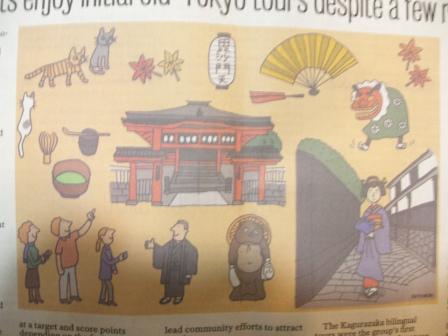 |
The Kagurazaka bilingual tours were the group's first project involving
non-Japanese. Kigawa and Sakamoto were both students of the initial classes
at Tokyo Planner Juku. She approached Sakamoto, suggesting they work together.Kigawa
also invited Catherine Oden, director of the French Tourism Office in Tokyo,
as a tour adviser.Oden, who has lived in Japan for 11 years and is fluent
in Japanese, is a three-year Kagurazaka resident.After the first tours, Oden said: "Though I live in Kagurazaka, I
discovered some new places. The guide pointed out details I might never
have noticed."However, she added that the tours could have been improved
if the pace were a bit slower, allowing the foreign participants time to
better observe the surroundings. She added non-Japanese often have a "special
flair for finding things that may be overlooked by Japanese hosts."Working for French tourism offices in New York, Singapore and Tokyo for
more than 20 years, Oden is often asked to give lectures by Japanese government
officials, who'd like to see Japan emulate France, one of the top travel
destinations in the world.Oden says the first step is to increase opportunities
for foreign tourists to learn about Japan and its culture. How they are
treated here will make a difference in their home countries, she said.
"I believe foreigners who love Japan are also good promoters."After
the tours, Sakamoto's impression was to the point--"difficult.""Except for the language barrier, the most difficult part of guiding
foreigners is that we aren't sure what they want or what they are interested
in. Even though they are all from outside Japan, they are all not the same
and don't necessarily share the same interests," he said."We
are still in the experimental stage," Sakamoto said. "But we
think it's possible to use this as a stepping stone to attracting more
foreign tourists to Kagurazaka."Tour organizers had only three weeks
to prepare--to plan the routes, activities and send out press releases.
Kigawa spent a lot of time visiting concierges at major hotels in Tokyo
to ask them to place flyers in their lobbies."The tour guides and
interpreters should have hammered out more of the details beforehand,"
Kigawa said. "We see some things that need to be fixed next time.
But anyway, we were happy to hear the participants enjoyed the tours and
we'll do better next time."IJCEE is planning more walking tours in various venues around Tokyo, plus
boat tours on the Sumidagawa river and koto workshops.At the same time,
the group plans to retrain tour guides. Targeting government-licensed guides
and others, the group will host a series of public seminars on traditional
Japanese culture and inbound tourism, starting in January.The lecturers
include freelance journalist Elizabeth Kiritani, a Boston native who lives
in Yanaka, one of Tokyo's shitamachi (downtown) neighborhoods, and Yuichiro
Ando. A specialist in modern Japanese history, Ando has written books on
the Edo Period.To provide a good tour, guides should educate themselves first, Kigawa
said."Most tourists who come to Tokyo are more interested in the old
Edo aspect of the city than the modern urban landscape. Indeed, sometimes,
they know more about the Edo culture than us Japanese. A superficial tour
won't work for them."I think a lot of Japanese people have forgotten
the spirit of the old Edo culture. While our group is trying to teach visitors
Japanese culture, there are also so many things we can learn from them,
too."(IHT/Asahi: November 3,2007)
|







